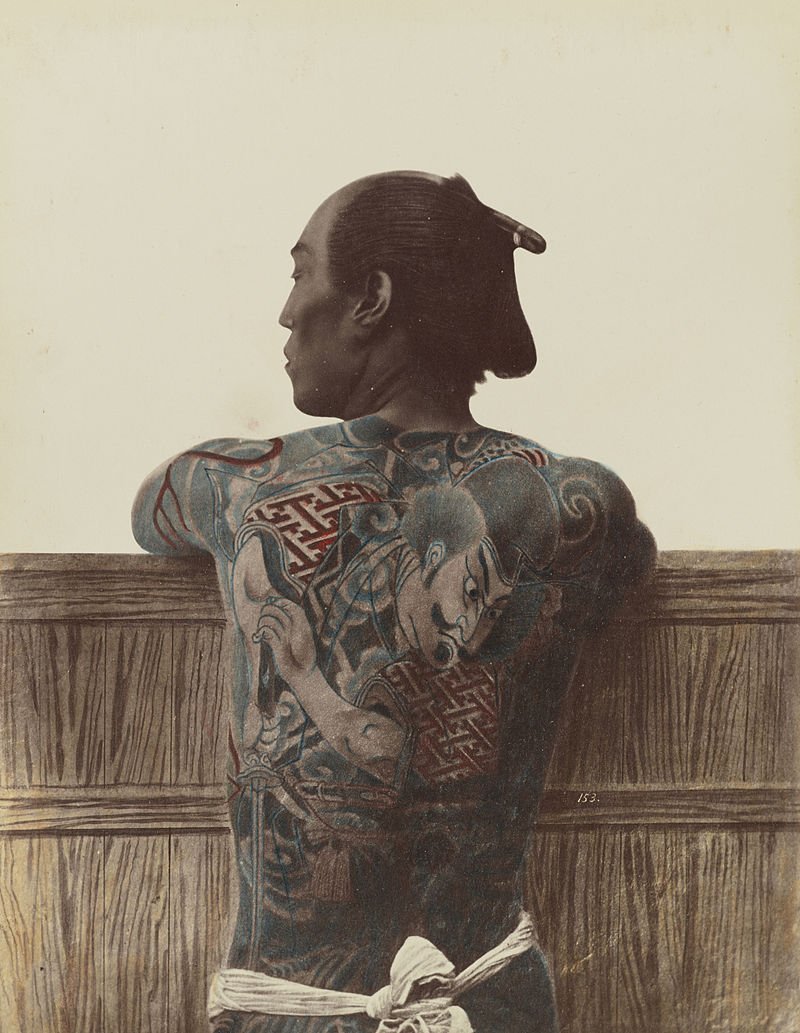Tattooing in Japan: A Cultural Tapestry
Origin of Irezumi: Echoes of Folklore and Japanese Tattoo Symbols
Tattooing in Japan, known as Irezumi, has deep roots in ancient Japanese folklore. The art form emerged as a means of depicting legendary heroes and mythical creatures, using vibrant inked designs to tell captivating tales. Over time, Japanese tattoo symbols became integral to Irezumi, transforming it into more than just a form of artistic expression; it became a symbol of personal identity, social status, and spiritual connection. Additionally, it draws inspiration from religious icons, historical characters, scenes from nature, and well-known Japanese fables. Japanese tattoo design, characterized by large-scale motifs, captures the essence of mythology and cultural heritage.
Techniques & Symbolism: The Artistry Unveiled in Irezumi Tattoo
The craftsmanship and techniques behind Japanese tattoo (also known as Horimono and Wabori) design and Irezumi tattoos are nothing short of extraordinary. Skilled tattoo artists, referred to as horishi, employ traditional methods and hand tools to create intricate masterpieces. The process involves painstakingly hand-poking designs into the skin with sharpened needles, using natural pigments derived from plants and minerals to enhance the tattoo's vibrancy. Symbolism plays a pivotal role, with motifs representing elements of nature, folklore, and spiritual beliefs intricately woven into larger compositions in the distinctive Japanese tattoo style.
Rules for Japanese Tattoos: Blending Tradition and Expression
Understanding the rules for Japanese tattoos adds depth to the cultural significance of Irezumi. Rule One emphasizes the importance of a large tattoo, covering a broad area or entire body part. Rule Two underlines the incorporation of themes and symbols representing Japanese culture in traditional Japanese tattoos. Most crucially, Rule Three stresses that the tattoo design and application should predominantly adhere to these traditional guidelines.
While Irezumi has always held a revered place in Japanese society, it faced periods of societal scrutiny and cultural transformation. Historically associated with criminality due to its connection with the yakuza, tattoos were stigmatized, leading to restrictive policies and negative public perception. However, in recent years, there has been a resurgence of interest in traditional tattooing. A renewed appreciation for the art form's beauty, historical importance, and cultural value has brought about a thriving tradition, attracting enthusiasts both domestically and internationally. The popularity of Irezumi dragon tattoos and the broader Japanese tattoo style has contributed to this cultural renaissance.
Symbolic Meanings: Decoding Japanese Tattoo Imagery
Delving into the symbolic meanings of Japanese tattoos, the frog in Japanese tattoos represents good luck and fertility. Meanwhile, the fox tattoo holds significance as a symbol of intelligence and magical abilities. The koi fish tattoo embodies perseverance and determination, representing overcoming adversity.
Irezumi vs. Regular Tattoos: Understanding the Difference
Distinguishing between tattoo and Irezumi is crucial in appreciating the unique characteristics of traditional Japanese tattooing. Irezumi, sometimes used to refer to a specific kind of tattoo, is designed as a large piece to be worn under clothes, covering significant parts of the body. This distinct style can extend from the edge of the neck to the buttocks, excluding the neck itself, face, or hands.
The Why Behind Irezumi: Social Status and Occupation
Historically, Irezumi tattoos served as reflections of individuals' social status or occupation. During the Edo period, intricate full-body suits were associated with firemen, manual laborers, and the Yakuza – Japan's infamous organized crime syndicate. Understanding the historical context adds depth to the allure and significance of Irezumi as a form of self-expression and cultural identity.
In conclusion, irezumi stands as a testament to Japan's artistic nature, cultural identity, and connection with its past. The detailed designs, meticulous techniques, and profound symbolism embedded in traditional Japanese tattoos evoke admiration and intrigue. These tattoos serve as living reminders of the stories, beliefs, and values that have shaped Japan's rich cultural landscape, showcasing the enduring power of art to transcend time and leave an indelible mark on the human experience.


